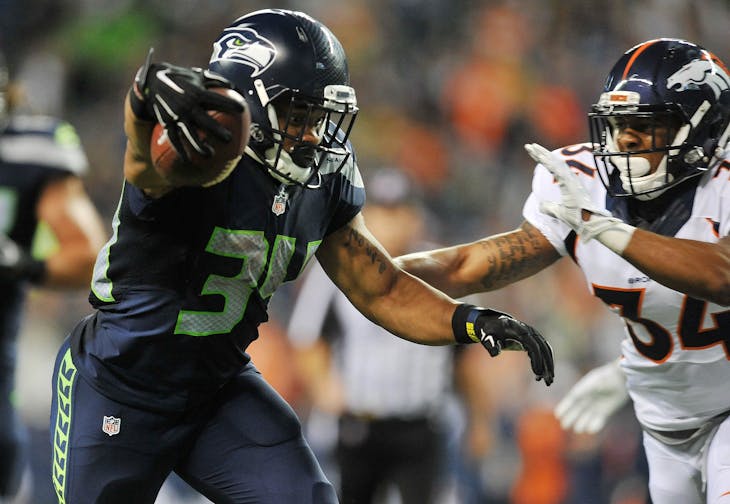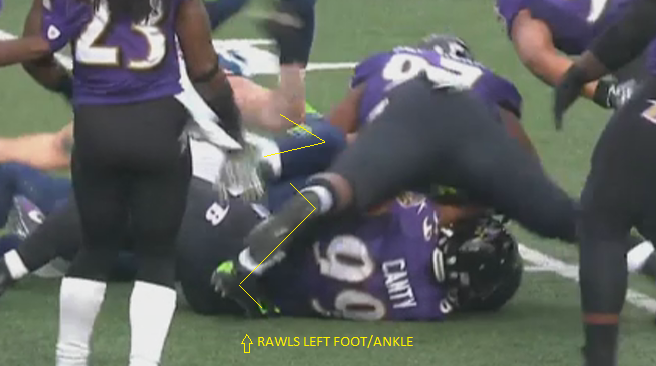
During the offseason, player injuries should always be seen as developing situations. Players felt to have relatively minor conditions are later reported to have needed surgery in the spring. Players who should have been ready much earlier in the preseason have setbacks that aren’t reported until OTAs, or even training camp.
The latest developing situation involves Thomas Rawls, whether he had surgery on his injured ankle, and why Pete Carroll continues to tell reporters his “hope” is Rawls will return healthy for Week 1.
The reporting on Rawls has been tough to read from the start. Most sources around the team have denied Rawls had surgery since January, although one lesser source included a brief note about surgery back in January.
Jene Bramel found Carroll’s comments odd in early June and raised concern about the severity of Rawls’ injury. Last week, in a conversation with Rotoworld’s Evan Silva, former NFL team physician and experienced injury analyst Dr. David Chao flatly said he believed Rawls had surgery.
With Rawls’ heading into his six month of rehab and still no clear timetable for a return, there’s clearly more here than has been reported. It raises lots of questions for Rawls’ immediate and long-term future. Jene and I collaborated to discuss the most critical issues.
Question 1: Is the revelation that Rawls needed surgery for his ankle injury a surprise?
Jene: Not really. When I reviewed the mechanism of injury in December, I thought Rawls suffered a high-grade high ankle sprain. The team immediately reported a fracture and ligament tear, which prompted me to speculate Rawls was likely to have surgery. I took the initial reports Rawls didn’t have surgery to be an optimistic sign that his injury wasn’t severe enough to fix.
But Carroll’s comments in mid-May – “hope remains” Rawls will be ready for the start of the season – had me reconsidering my optimism. I'm not aware of any non-surgical ankle rehab protocols with an 8-9 month rehab expectation. I rewatched the injury mechanism and again searched for comments about a possible surgery. Not finding anything of note, I hedged in my early June injury feature. I wrote that Carroll comments were odd and raised important flags but wasn’t comfortable writing “Despite what’s being reported, Rawls had surgery.”
What could be seen of the injury mechanism suggested a high ankle sprain severe enough to require surgery.

The team’s immediate report of the injury – fracture with ligament tear – matches the mechanism and suggested surgery. Chao believes Rawls had surgery. The length of Rawls’ rehab is consistent with surgery. At this point, the only surprise is that the story didn’t break much sooner.
Craig: It shouldn’t be, yet somehow it is. Rawls fractured his ankle, and head coach Pete Carroll immediately mentioned that there was a concern for ligament damage as well. That alone almost guarantees a surgical treatment. The trouble here was that it was quickly reported that Rawls would not need surgery after all, and most outlets just seemed to stick to that story until the present. Add in the fact that Carroll, as optimistic of a guy as you’ll ever find when it comes to injuries, has repeatedly attempted to reel in the expectations for Rawls’ summer and preseason participation, and we should’ve known that Rawls was dealing with a more severe ankle fracture, likely with additional ligament damage.
Question 2: does this reset Rawls' recovery timeline? is he further behind in his rehab than expected?
Jene: The puzzle pieces suggest two possible injuries. Rawls likely suffered a high-grade high ankle sprain (broken fibula and torn syndesmosis) or a dislocation somewhere in his ankle joint (by definition a ligament tear, sometimes includes broken bones). As Chao noted, the longer rehab timeline raises questions about a fracture/dislocation. Most players recover from surgical fixation of high ankle injuries much sooner than 6-9 months.
Craig: It’s tough to tell, as we don’t have any real updates on exactly where Rawls currently is in his activity. We have zero reports of what Rawls is actually doing, whether he’s running, cutting, making football movements, or anything else. If the injury was severe enough to require surgery, especially for ligament damage, it would be expected that Rawls would take somewhere in the ballpark of 6-9 months as Dr. Chao mentioned. Rawls is currently 6 months removed from the injury, and the season starts in roughly another 3 months. Without knowing what level Rawls is currently at, we can have no way to place where he is on that recovery path.
Jene: Exactly, without knowing precisely what Rawls has been cleared to do, it’s impossible to gauge whether he’s behind in rehab. In late March, Rawls said he’d be running soon. And he’s been saying he’ll be ready for camp and for the regular season for some time.
Here’s where Carroll’s comments could be seen in a different context. Initially, they raised crimson red flags that something more than what had been reported was happening here. Now, in light of the likelihood Rawls had a more severe injury and longer rehab/recovery timeline, they might be seen as true optimism. Hopefully, we’ll get more on Rawls’ recovery status before camp.
Question 3: Should we adjust our expectations for Rawls’ performance for this season?
Craig: Absolutely, though again, it’s tough to pin much down without knowing what activities Rawls is currently capable of. In my mind, knowing that this was a more extensive injury helps explain some of the moves by Seattle at the running back position. Seattle drafted three running backs in this year, and also retained free agent Christine Michael despite his sparse use last season. Given this new information about surgery, I can’t help but think that Seattle recognizes Rawls’ health might be more volatile than originally reported and that they’re prepared for the worst. This is pure speculation on my part, but it also makes me wonder if Seattle will take their time easing Rawls back into a running back by committee rotation if/when he returns to full health. I think we might be seeing a drastic change in roles for anyone who was expecting to see Rawls take on all the workload of departed Marshawn Lynch. Again, though, that’s just a hunch based on what I’m seeing, so take it with the proverbial grain of salt.
Jene: I agree. I’m not ready to predict doom and gloom for Rawls yet. Even the more severe injuries we’re speculating about today are often associated with full recoveries. It seems clear the Seahawks aren’t going to ask Rawls to participate heavily in the early weeks of camp. They refused to put an RFA tender on Michael but re-signed him quickly in March. They added three backs in the draft, one in the third round, then added another UDFA fullback they liked after the draft. None represents a threat to Rawls if he’s healthy. Whether they were added as true hedges or needed depth with Marshawn Lynch retired remains to be seen. If the Seahawks add an experienced, accomplished veteran back between now and training camp, it’s a definite worry.
Question 4: what should we be watching for between now and the regular season?
Craig: Yes, but we should be listening as well. We need to watch for any sort of practice participation from Rawls. Without that, I think it’s safe to say that we’re multiple weeks, if not more, away from playing. We also need to be listening for any more pessimism from Pete Carroll. Once you’re tuned to his optimistic frequency, anything pessimistic will stand out as very revealing. If you hear Pete Carroll even mention the possibility that Rawls begins the season on the physically unable to perform list, you can go ahead and assume that he’s nowhere close to a return.
Jene: Knowing that anything Carroll says needs to be understood in context, we’ll hopefully get an interview with Rawls with more details before camp. Otherwise, I think the decision on whether Rawls starts on PUP will be our next indication. If Rawls starts on PUP, we need to listen carefully to why. If the expectation is just that he needs a little extra conditioning and the team is continuing to keep all options open, he may come off in a week with no long term concern. If it’s more than that, it’s a clear cause of 2016 concern.
We'll be following the Rawls' injury throughout the summer. Follow Jene and Craig on Twitter for discussion of every NFL injury and feel free to chime in if you have specific questions.

_png)